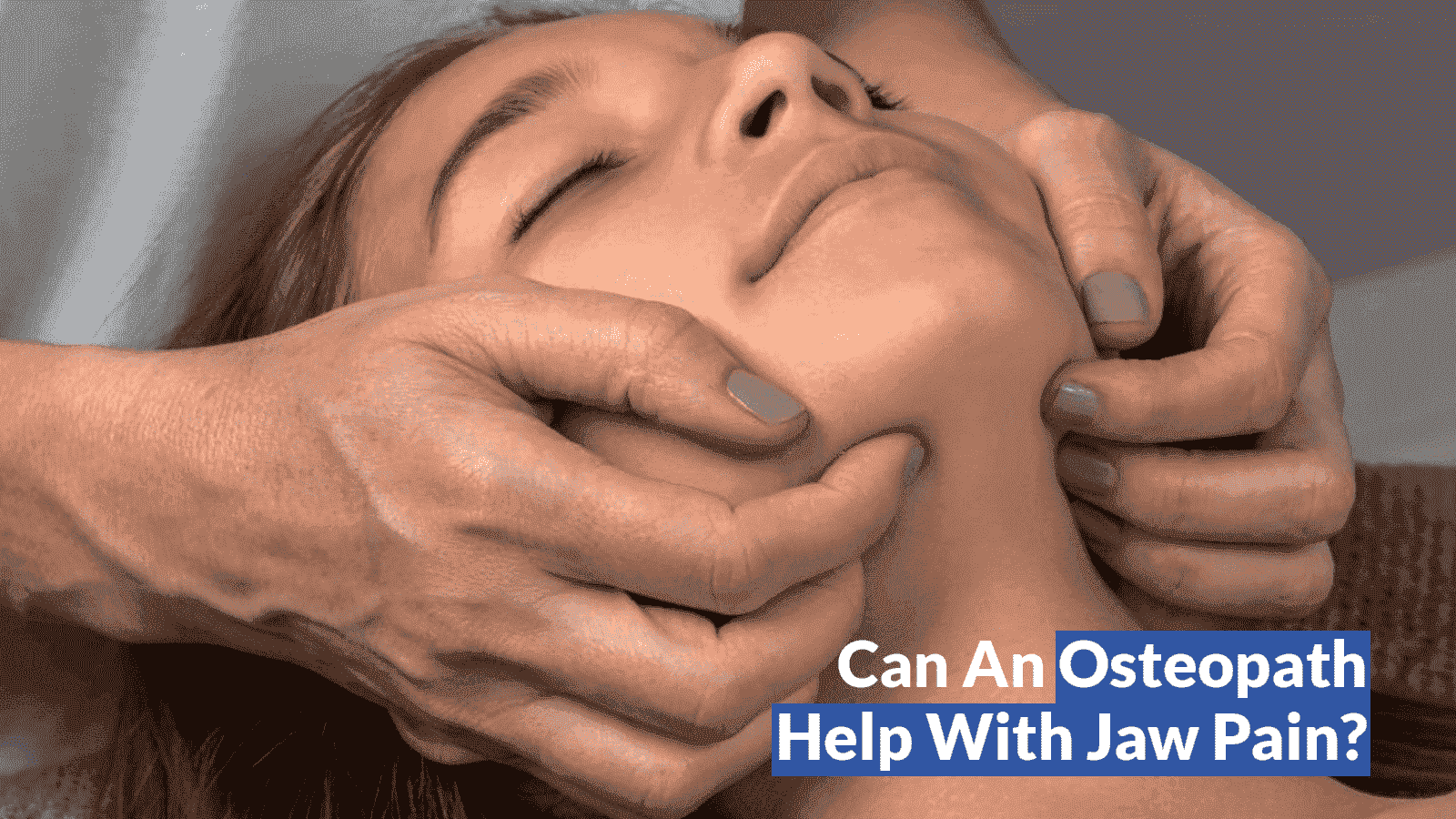Jaw pain can be an incredibly uncomfortable and distressing experience for everyone – whether the sufferer is young, old, or somewhere in between. Jaw discomfort may not get as much attention as back pain or head pain – This does not imply, however, that jaw pain is trivial, not unpleasant, or ineffective in everyday life.
Good news! Osteopathy can help. Osteopaths for jaw pain address the underlying causes and restore optimal function. Whether you’re experiencing muscle tension, limited jaw movement, or other symptoms related to temporomandibular joint disorder (TMD), seeking the assistance of an osteopath for jaw pain can be a step towards finding relief from not-so-comfortable jaw pain.
Types of Jaw Pain in Temporomandibular Joint Disorder (TMD)
Temporomandibular joint disorder (TMD) encompasses a spectrum of jaw-related conditions, each with its own set of symptoms and causes. Some common types of jaw pain associated with TMD include:
- Myofascial Pain: This type of jaw pain arises from muscle tension and trigger points in the jaw muscles. It often causes localised discomfort, tenderness, and limited jaw movement.
- Internal Derangement: Internal derangement refers to structural abnormalities within the jaw joint, such as a displaced disc or a misaligned jaw. This can result in clicking or popping sounds, jaw locking, and difficulty in opening or closing the mouth.
- Arthritis: Arthritis can also affect the jaw joint – leading to pain, inflammation, and limited mobility.
- Bruxism-Related Pain: While physical factors contribute to jaw pain, emotional stress can also play a significant role. Bruxism, or teeth grinding, can exert excessive pressure on the jaw joint and surrounding structures, leading to jaw pain. It often occurs during sleep and is often associated with stress, anxiety, or lifestyle habits.
Osteopathy for Jaw Pain
One of the primary culprits of jaw pain is the temporomandibular joint, commonly known as TMJ. Located in the skull, this intricate joint enables basic movements like talking, chewing, and yawning. When the TMJ is affected, it can lead to relentless jaw pain and unusual discomfort.
Osteopathy offers a drug-free approach to treating jaw pain associated with TMD. When it comes to jaw pain, osteopathic treatment aims to address the underlying causes, alleviate discomfort, and restore optimal jaw function. Through gentle manual techniques, osteopaths for jaw pain address muscle tension, improve joint mobility, and restore balance to the surrounding structures. Whether the jaw pain is provoked by muscle tension, misalignment, or other underlying factors, osteopathy can help alleviate discomfort and restore optimal function to the jaw.
What An Osteopathy Appointment For Jaw Pain Looks Like
When you visit an osteopath for jaw pain, they will conduct a comprehensive assessment to understand the root causes of your pain. Osteopaths will take into account:
- Your medical history
- Symptoms
- Lifestyle factors
Here’s what you can expect from osteopathic treatment for jaw pain:
Comprehensive assessment
The osteopath for jaw pain will dig deep into your jaw pain. Along with noting down your jaw pain’s onset, duration, and any associated symptoms, osteopaths will also consider factors such as previous injuries, medical conditions, and lifestyle habits. Additionally, osteopaths offer insight into the emotional causes of jaw pain – stress, for instance.
Hands-on techniques
Osteopaths use a variety of gentle manual techniques to address jaw pain. The osteopath may use techniques such as soft tissue massage, joint mobilisation, and stretching to relieve muscle tightness and promote healing.
Inter-oral techniques
Inter-oral techniques involve the osteopath gently manipulating the muscles and tissues inside the mouth to address jaw tightness and discomfort. This approach is highly effective in reducing jaw tightness and relieving associated headache symptoms. The osteopath will use their expertise to ensure these techniques are applied safely and comfortably.
Exercises
Alongside hands-on techniques, the osteopath may provide specific exercises to improve jaw function and strengthen supporting muscles. These exercises are designed to promote flexibility, enhance joint stability, and reduce muscle tension.
In addition to the physical aspects of treatment, an osteopath may address emotional factors contributing to jaw pain. They may suggest stress management techniques, such as mindfulness or relaxation exercises, to help reduce anxiety and promote overall well-being.
Relieve Jaw Pain with Home Care Strategies
Alongside osteopathic treatment, several home care strategies can complement your recovery process and help alleviate jaw pain associated with the temporomandibular joint disorder (TMD). These strategies include:
Stretching exercises
Performing specific jaw stretching exercises can help relieve muscle tension and promote relaxation. Some recommended exercises include relaxed jaw exercises, goldfish exercises for partial and full opening, chin tucks, resisted opening and closing of the mouth, tongue-up exercises, side-to-side jaw movements, and forward jaw movements. These exercises, when done under guidance and when the pain is manageable, can contribute to reducing TMJ pain and enhancing jaw function.
Self-massage techniques
Massaging the aching jaw muscles can help release tension and promote neuromuscular harmony between the joint, tooth contact, and muscles. Combining the massage with a warm compress can enhance its effectiveness.
Posture correction
Poor posture can contribute big time to jaw pain. Hunching or slouching can misalign your body, including your neck, which can put stress on the temporomandibular joint (TMJ). To reduce strain on your TMJ and promote proper alignment, try sitting up straight at your desk.
Cold and heat therapy
Applying cold packs can help numb the joint, reduce inflammation, and alleviate sudden sharp pain caused by inflammation. If the pain persists for more than a few days, switch to moist heat compresses. These can be used at least four times a day to provide warmth, promote relaxation, and relieve chronic TMJ pain.
Stress management
Stress and tension can exacerbate jaw pain. Engaging in stress management techniques such as listening to soothing music, practising relaxation exercises, or avoiding screen time before bed can help reduce stress and promote a sense of calm.
Dietary modifications
Chewing tough or crunchy foods can strain the jaw joint. Temporarily refrain from consuming items like steak, jerky, bagels, hard fruits and vegetables, nuts, and chewy candies. Opt for softer, easier-to-chew foods that put less stress on the jaw.
Limiting gum chewing
Chewing gum can put excessive force on the jaw muscles, leading to imbalance, misalignment, and added stress on the TMJ. Limiting or discontinuing gum chewing can help reduce strain on the jaw joint and alleviate associated pain.
The Best Osteopath for Jaw Pain Near Me
When seeking treatment for jaw pain, it’s essential to choose a trusted healthcare professional who specialises in osteopathy. Osteopath Sydney, led by Dr Phill, is renowned for their expertise in providing comprehensive care for various conditions, including jaw pain associated with TMD. With their extensive knowledge and experience, our osteopaths treat jaw pain while offering tailored treatment plans that address the specific causes of jaw pain and promote long-term relief.


